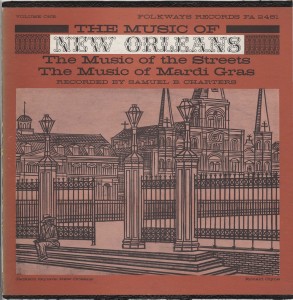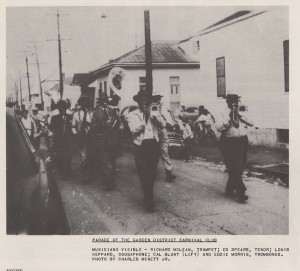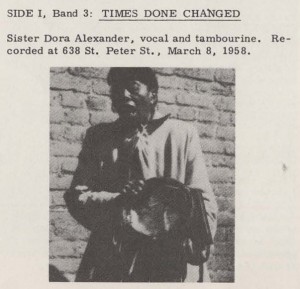In tribute to the great Samuel Charters – poet, novelist, translator of Swedish poets, and renowned scholar of the blues, jazz, and musical culture of the African diaspora – we feature in coming weeks the words and recordings of Samuel Charters, collected and preserved in The Samuel and Ann Charters Archives of Blues and Vernacular African American Musical Culture at the University of Connecticut. Samuel Charters died on March 18 at the age of 85.
 Before Samuel Charters’ seminal book The Country Blues was published in 1959, Mr. Charters had been researching and conducting field recordings of the rich musical traditions of New Orleans. In his writings and interviews throughout his life, Mr. Charters often recalled his childhood, immersed in the sounds of classical music and jazz. In 1956, Folkways Records released The Music of New Orleans. The Music of the Streets. The Music of Mardi Gras, recorded by Samuel Barclay Charters and produced by Moses Ash. In his extensive liner notes, Mr. Charters writes:
Before Samuel Charters’ seminal book The Country Blues was published in 1959, Mr. Charters had been researching and conducting field recordings of the rich musical traditions of New Orleans. In his writings and interviews throughout his life, Mr. Charters often recalled his childhood, immersed in the sounds of classical music and jazz. In 1956, Folkways Records released The Music of New Orleans. The Music of the Streets. The Music of Mardi Gras, recorded by Samuel Barclay Charters and produced by Moses Ash. In his extensive liner notes, Mr. Charters writes:
“The aim of this group of recordings – done in the city in the seven years between 1951 and 1958 – was to find and preserve as much of the cities musical tradition as possible. Here is the music of the brass bands, the dance halls, Mardi Gras, and the music of the streets themselves. The music of shoe shine boys, vegetable criers, guitar players, and street evangelists. The music that was recorded was as much as possible the distinctive music of the city.”
Mr. Charters’ book Jazz New Orleans, 1885-1957 followed in 1958. In his inventory to The Samuel and Ann Charters Archives of Blues and Vernacular African American Musical Culture, Mr. Charters tells us the story behind the book:
“Walter C. Allen was a research chemist and jazz hobbiest who published a series of Jazz Monographs, of which this was Number 2. He was responsible for typing the manuscript and designing the book, which came out a few months after I sent him the manuscript. The book had involved several years of research in New Orleans and then a long period of writing, and my advance against royalties from Walter was $5, which even that long ago didn’t really seem like a lot of money.”
Excerpted below from the liner notes of The Music of New Orleans. The Music of the Streets. The Music of Mardi Gras., is Samuel Charters.
New Orleans is a gentle, sprawling city lying between Mississippi River and Lake Panchartrain on the Mississippi delta in southern Louisiana. In its early years the city grew beside the river, and against the levees the small streets follow its great crescent curve. …
The city’s remoteness and its colorful past have given it an easy self-assurance and a feeling of continuing tradition that is very different from anything else in America. There is an open disinterest toward contemporary art, music and culture that dismays the energetic outsider who moves to the city. There is almost as little conscious effort made to preserve the city’s own cultural traditions. It is a relatively poor city, but it is a very relaxed city. This may be because even in the poorer neighborhoods the streets are lined with one story wooden houses, rather than large tenements. There is a feeling of spaciousness and sunlight. The weather, despite the hot summers, is beautiful. … Living is relatively cheap, and between the docks and the tourists there is usually some kind of job around. An old musician, laughing, said once, “It used to be if you had a minds to, you could go any place in the city and get a job on Monday morning because you ‘d be the only person around that felt like working.” [Richard Alexis – in an interview in 1955]
In the nineteenth century the city was filled with music. There were brass bands, string orchestras, amateur symphonies, and wandering street singers. Dozens of little orchestras played for the endless social gatherings in the Vieux Carre. Rougher bands played in the dance halls near the river for the longshoremen and the men off the ships. With the social life, the long summers, and the dozens of resorts there was probably more music in New Orleans than in any city in the country. The music does not seem to have been entirely distinctive. The musicians relied on standard orchestrations from the New York publishing houses. The French community carries on some of the French musical tradition, centered around its French Opera House, but unlike the bitter, resentful Acadians west of the city who rejected any non-French culture, the Vieux Carre was as much concerned with being “cultured” as it was with being simply French.
In the last years of the century and until about the time of the first World War the city was troubled with far reaching changes in social structure. Because of an influx of new families there was for several years an overcrowded tenement condition in some of the poorer Negro neighborhoods, on the upriver side of Canal Street, the Creoles of Color – French speaking mixed bloods – were included in the general restrictions of legislated segregation, and a large district near the downtown business district was opened for prostitution and gambling. Each of these factors contributed to the development of a local orchestral dance style that was to be the heart of American jazz music. …
The aim of this group of recordings – done in the city in the seven years between 1951 and 1958 – was to find and preserve as much of the cities musical tradition as possible. The music that somehow captured some of this relaxed, romantic past. Here is the music of the brass bands, the dance halls, Mardi Gras, and the music of the streets themselves. The music of shoe shine boys, vegetable criers, guitar players, and street evangelists. The music that was recorded was as much as possible the distinctive music of the city. …
Here in all it variety and glory is the music of New Orleans.
Sister Dora Alexander, a “colorful street evangelist who makes a meager living singing on the streets of Vieux Carre”, sings Times Done Changed (from Smithsonian Folkways):


